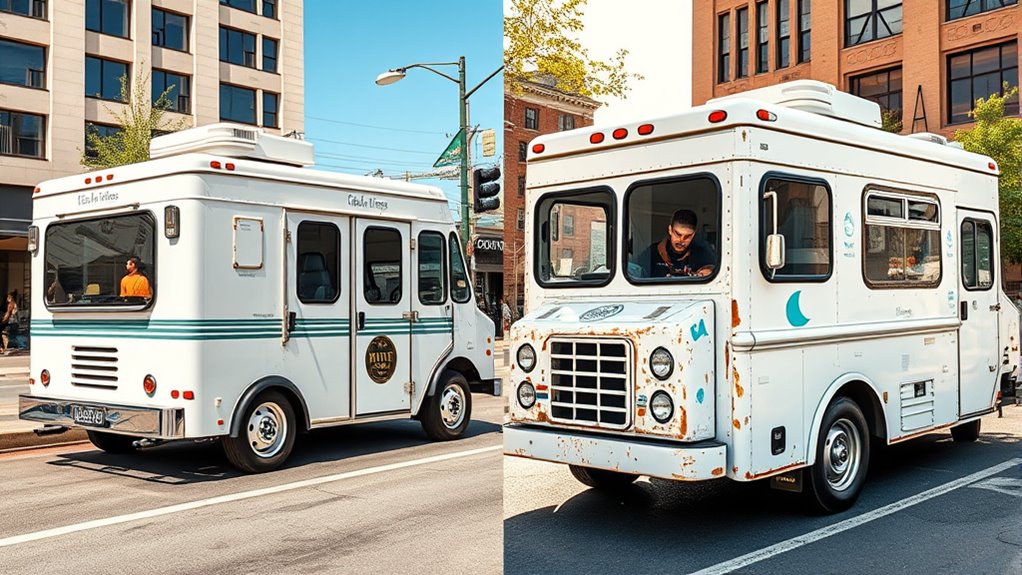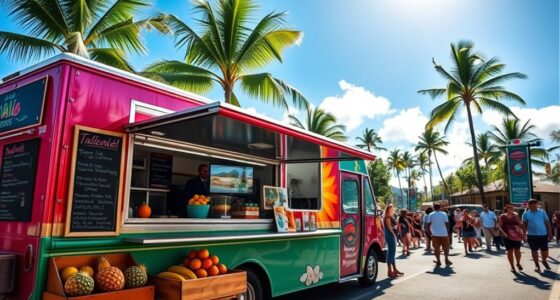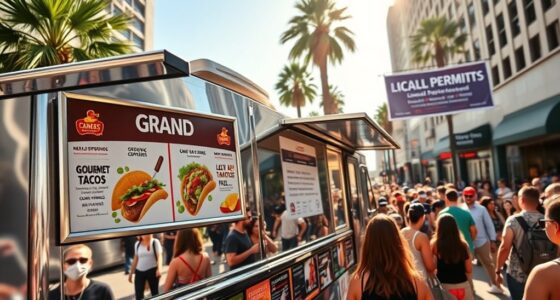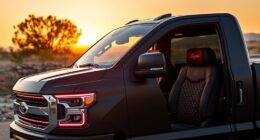Choosing between a new or used food truck involves balancing upfront costs with ongoing expenses. New trucks cost more initially but typically need fewer repairs, lowering maintenance bills early on. Used trucks are cheaper upfront but may require more frequent repairs, increasing maintenance costs over time. Insurance for new trucks is usually higher but may benefit from advanced safety features. To get a clearer picture of total costs and find the best fit, explore the details below.
Key Takeaways
- New food trucks have higher upfront costs but lower initial maintenance and repair expenses.
- Used trucks are more affordable initially but may incur higher ongoing repair and maintenance costs.
- Insurance premiums are typically higher for new trucks due to higher value and safety features.
- Older trucks may lack modern safety features, possibly increasing insurance and repair costs.
- Balancing initial purchase price with long-term maintenance and insurance expenses is key for budget planning.

Ever wondered where your money really goes when you make a purchase? When it comes to starting or expanding your food truck business, understanding the cost breakdown is essential. One of the biggest ongoing expenses is vehicle maintenance. Whether you buy a new or used food truck, keeping it in good shape can eat into your budget. New trucks usually come with fewer repairs initially, meaning lower maintenance costs early on. However, as your used truck ages, you might find yourself spending more on repairs and upkeep, which can add up quickly. Regular checks, tire replacements, brake repairs, and engine servicing are inevitable, but the frequency and cost vary depending on the truck’s age and condition. Investing in a newer vehicle might mean paying a premium upfront but could save you money down the line with fewer repairs needed. On the other hand, used vehicles often have lower purchase prices, but they tend to have higher maintenance costs over time, so you need to factor that into your budget. Additionally, understanding the vehicle lifespan can help you plan for long-term expenses and replacement strategies.
Insurance costs are another significant part of your expenses, and they fluctuate depending on whether you opt for a new or used truck. Newer vehicles generally cost more to insure because their replacement value is higher, and insurance companies see them as more valuable assets. Plus, newer models tend to come with the latest safety features, which can sometimes lower premiums, but overall, they usually remain more expensive to insure than used trucks. Used food trucks typically have lower insurance premiums because their value is less, but keep in mind that older vehicles might be considered riskier by insurers, especially if they lack modern safety features. Your driving history, location, and coverage options also influence insurance costs, so shop around to find the best deal.
When weighing the costs between a new and used food truck, it’s essential to consider these ongoing expenses. While a new truck might be more reliable and require less immediate vehicle maintenance, it comes with higher insurance costs and a steeper initial investment. A used truck can be more budget-friendly upfront and might have lower insurance premiums, but you should be prepared for potentially higher maintenance and repair bills as it ages. Balancing these factors helps you determine which option aligns best with your financial situation and business goals. Ultimately, understanding the real costs behind vehicle maintenance and insurance helps you make a smarter investment, ensuring your food truck business remains profitable and sustainable over time.
Frequently Asked Questions
What Are the Common Hidden Costs in Food Truck Purchases?
Hidden costs in food truck purchases often include depreciation expenses that chip away at your investment over time. You might also overlook expenses like permits, insurance, maintenance, and unexpected repairs. These hidden costs can add up quickly, affecting your profit margins. To avoid surprises, budget for ongoing costs and consider how depreciation impacts your overall financial picture. Being aware of these hidden costs helps you make a smarter, more informed purchase decision.
How Does Maintenance Differ Between New and Used Trucks?
Did you know that used trucks typically need maintenance twice as often as new ones? You’ll find that new vehicles offer better durability, meaning fewer repairs and less downtime. With a used truck, you’ll likely face more frequent maintenance, which can add up over time. If you want reliability and lower ongoing costs, a new food truck is the smarter choice for sustained vehicle durability and reduced maintenance frequency.
Are Warranties Generally Included With Used Food Trucks?
Warranty coverage on used food trucks varies, but many sellers offer used truck assurance options that include limited warranties. You should ask the seller about any included warranties and what they cover, like engine or transmission repairs. Keep in mind, used trucks often have shorter or less extensive warranties than new ones. Always review the warranty details carefully to ensure you’re protected against unexpected repairs and costs.
What Financing Options Are Available for Used Trucks?
You can explore used truck financing options like used truck loans through banks, credit unions, or specialized lenders. These options often require a good credit score and a down payment. Some lenders offer flexible terms, making it easier to afford a used truck. Be sure to compare interest rates and repayment plans to find the best deal. Securing used truck financing helps you get your food truck business rolling without upfront full payment.
How Does Insurance Cost Vary Between New and Used Trucks?
Irony strikes again—insurance premiums for new trucks are often higher because insurers see them as riskier, despite their shiny appeal. You’ll find that coverage options for used trucks tend to be more affordable, thanks to their lower value and perceived stability. So, if saving on insurance costs matters, choosing a used truck might be smarter. Just remember, coverage options vary, so compare policies carefully before making your decision.
Conclusion
Ultimately, whether you choose a new or used food truck, understand your costs, plan your budget, and weigh your options. A new truck offers freshness, reliability, and the latest features, while a used truck provides affordability, familiarity, and potential for upgrades. Both paths require careful consideration, strategic investment, and clear expectations. By knowing what to expect and making informed decisions, you can turn your food truck dreams into a successful, rolling reality.









